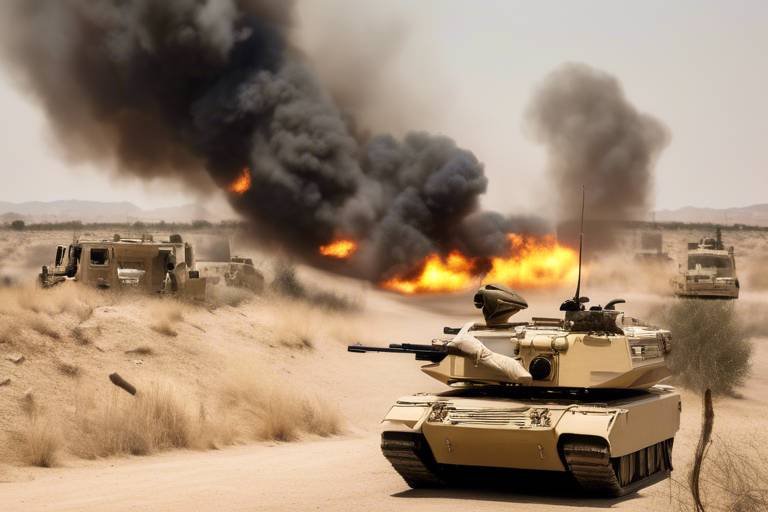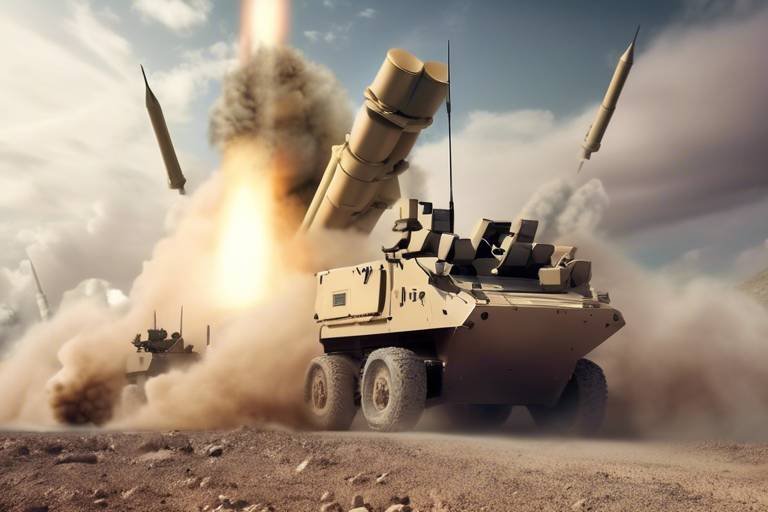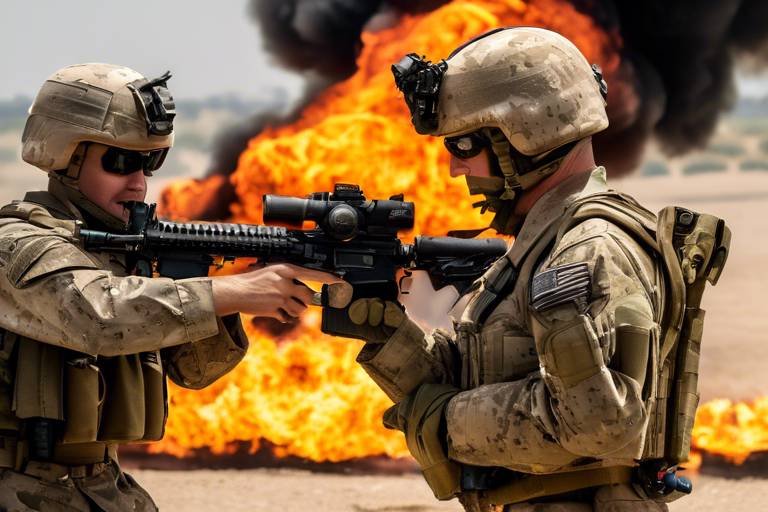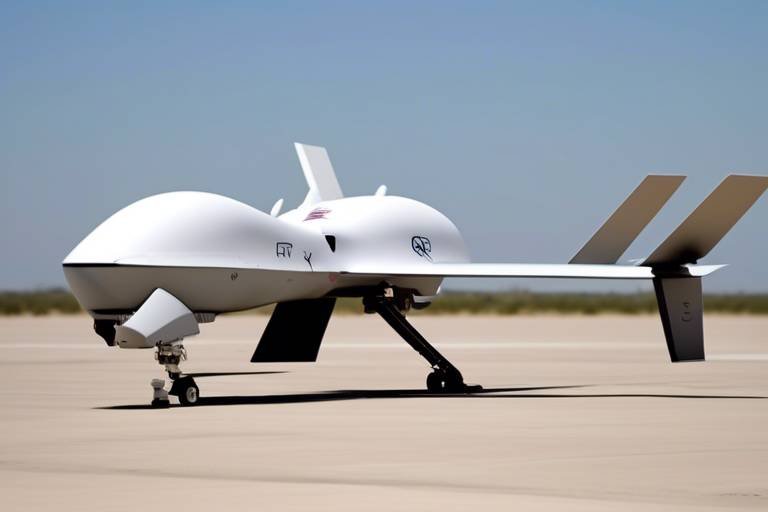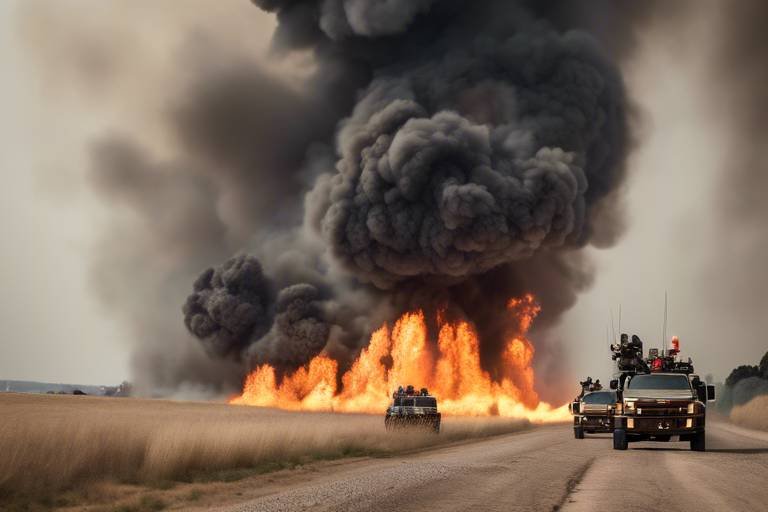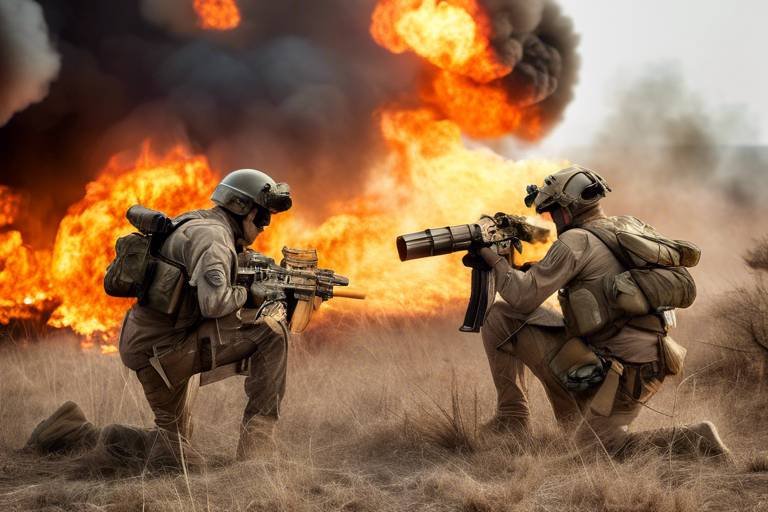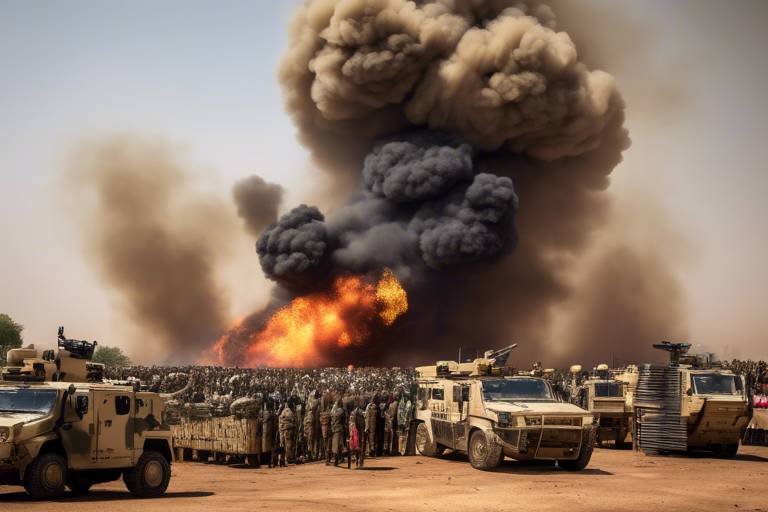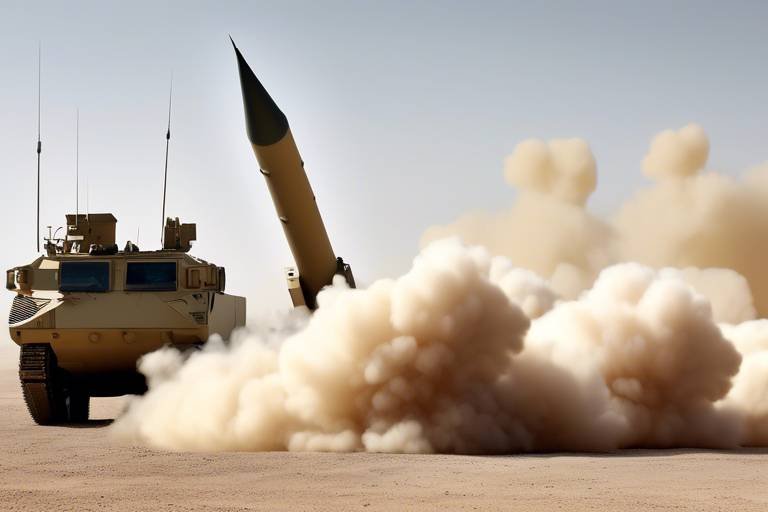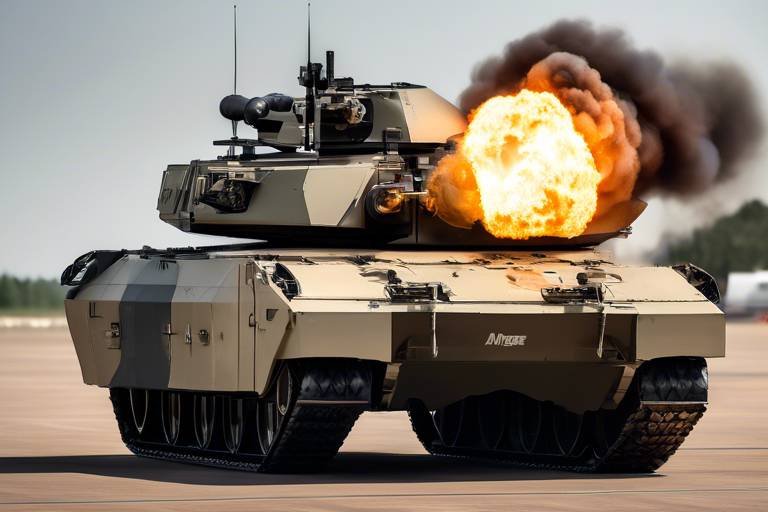The Use of Non-Lethal Weapons in Modern Military Operations
In today's world, the landscape of military operations is constantly evolving, and with it, the methods and tools used by armed forces. One significant development has been the increased focus on non-lethal weapons. These innovative tools are designed to incapacitate or deter an enemy without causing permanent harm or death. Imagine a world where soldiers can effectively manage threats without the devastating consequences of traditional weaponry—this is the promise of non-lethal weapons.
Non-lethal weapons play a crucial role in various military engagements, from crowd control to peacekeeping missions. Their use reflects a shift towards more humane approaches in warfare, emphasizing the importance of minimizing collateral damage and protecting civilian lives. However, the effectiveness and ethical implications of these weapons are subjects of ongoing debate. As we delve deeper into this topic, we’ll explore their definition, historical context, types, advantages, challenges, ethical considerations, real-world applications, and future developments.
Understanding what constitutes non-lethal weapons is essential for grasping their purpose and application in military operations. Non-lethal weapons are defined as systems designed to incapacitate individuals or material while minimizing fatalities and permanent injury. This category includes a variety of tools and technologies, such as chemical agents, acoustic devices, and directed energy systems.
These weapons are not entirely without risk; they can still cause harm if misused or improperly deployed. However, their primary goal is to provide military personnel with options that allow them to engage effectively without resorting to lethal force. This capability is especially valuable in scenarios where the use of deadly force could escalate tensions or lead to broader conflicts.
The evolution of non-lethal weapons has been shaped by historical military needs. The concept of using less lethal means to control situations dates back centuries, but it gained significant traction in the late 20th century. As conflicts became more complex and the international community began to stress the importance of humanitarian considerations, military organizations started to explore alternatives to traditional weaponry.
Key developments in non-lethal technology include the introduction of rubber bullets in the 1960s, which offered a way to disperse crowds without causing fatal injuries. The 1990s saw the advent of pepper spray and tear gas for riot control, further expanding the arsenal of non-lethal options available to law enforcement and military forces alike. Today, ongoing research and development continue to push the boundaries of what non-lethal weapons can achieve.
Various categories of non-lethal weapons serve different purposes on the battlefield. These can be broadly classified into several types:
- Chemical Agents: Such as tear gas and pepper spray, used primarily for crowd control.
- Acoustic Devices: These include sound cannons that emit loud noises to disperse crowds or deter intruders.
- Directed Energy Systems: Technologies like laser dazzlers that temporarily blind or disorient targets.
Each type of non-lethal weapon has its own unique applications and effectiveness, making them valuable tools in specific operational contexts.
Non-lethal weapons offer distinct advantages in military operations, including reduced fatalities and collateral damage. By providing alternatives to lethal force, these weapons can enhance mission success while minimizing humanitarian impact. For instance, in urban environments where civilians are present, the ability to incapacitate a threat without causing permanent harm is a game-changer.
Moreover, the use of non-lethal weapons can help maintain public order during protests or riots, allowing law enforcement to manage situations without escalating violence. This approach not only preserves lives but also fosters trust between military personnel and the communities they serve.
While non-lethal weapons present many advantages, they also pose challenges and limitations. One major concern is their effectiveness; in some cases, non-lethal weapons may not incapacitate a target as intended, potentially putting military personnel at risk. Furthermore, there is a risk of misuse, where individuals may deploy these weapons inappropriately or excessively.
Proper training is essential for the effective use of non-lethal weapons. Military personnel must understand the appropriate circumstances for their deployment and the potential consequences of their use. Without adequate training, the risks associated with non-lethal weapons can outweigh their benefits.
The use of non-lethal weapons raises ethical questions regarding their deployment and impact on civilians. While these weapons are designed to minimize harm, the potential for misuse or unintended consequences remains a concern. International laws governing the use of such weapons in conflict must be carefully considered to ensure compliance with humanitarian standards.
Additionally, the moral implications of using non-lethal weapons must be examined. Are we, as a society, comfortable with the idea of incapacitating individuals without the intent to kill? This debate is ongoing and requires thoughtful consideration from military leaders, policymakers, and the public alike.
Examining real-world applications of non-lethal weapons can provide insights into their effectiveness. For example, during recent peacekeeping missions, non-lethal options were utilized to manage crowds and prevent violence without escalating tensions. These case studies showcase how non-lethal weapons can be employed successfully in various operational contexts, highlighting their potential as vital tools in modern military engagements.
As technology advances, the future of non-lethal weapons remains a topic of interest. Emerging technologies, such as advanced robotics and artificial intelligence, could lead to the development of even more sophisticated non-lethal systems. These innovations have the potential to revolutionize military operations, providing armed forces with enhanced capabilities to address complex challenges while prioritizing humanitarian considerations.
1. What are non-lethal weapons?
Non-lethal weapons are systems designed to incapacitate individuals or material while minimizing fatalities and permanent injury. They include a variety of tools such as chemical agents, acoustic devices, and directed energy systems.
2. What are the advantages of using non-lethal weapons?
Non-lethal weapons offer distinct advantages such as reduced fatalities, minimized collateral damage, and the ability to maintain public order without escalating violence.
3. What are the ethical concerns surrounding non-lethal weapons?
The ethical concerns include the potential for misuse, the moral implications of incapacitating individuals without lethal intent, and compliance with international laws governing their use.
4. How effective are non-lethal weapons in real-world scenarios?
The effectiveness of non-lethal weapons can vary depending on the situation. Case studies from peacekeeping missions have shown their successful application in managing crowds and preventing violence.
The Definition of Non-Lethal Weapons
When we talk about non-lethal weapons, it's crucial to understand what this term actually means. Non-lethal weapons are designed to incapacitate or deter individuals without causing permanent harm or death. Unlike traditional weapons, which aim to kill or inflict serious injury, non-lethal options provide military and law enforcement with alternative methods to manage conflict situations. These weapons can range from chemical agents and acoustic devices to directed energy systems, each serving unique purposes in various operational contexts.
To put it simply, non-lethal weapons act like a fire extinguisher in a world full of fireworks. They offer a way to control a situation without the explosive consequences of lethal force. Imagine being in a tense standoff where both sides are on edge; deploying a non-lethal weapon can diffuse that tension without escalating to violence. This capability is what makes non-lethal weapons so appealing in modern military operations.
Understanding the types of non-lethal weapons is essential for grasping their potential impact. Here’s a brief overview of some categories:
- Chemical Agents: These include substances like tear gas or pepper spray, which can incapacitate individuals temporarily.
- Acoustic Devices: These weapons use sound waves to create discomfort or disorientation, making it difficult for individuals to focus or act.
- Directed Energy Systems: These systems utilize focused energy, such as lasers, to disable equipment or temporarily blind targets.
It's important to note that while non-lethal weapons are designed to minimize harm, they are not without risks. Misuse or improper deployment can still lead to unintended consequences, including severe injuries or fatalities. Therefore, a clear understanding of their definition and intended use is vital for military personnel and law enforcement officials alike.
In summary, non-lethal weapons are a fascinating aspect of modern military strategy. They embody a shift towards more humane methods of conflict resolution while still maintaining the ability to assert control. As we delve deeper into the historical context and types of these weapons, it becomes clear that their role in military operations is both significant and complex.
Historical Context
The journey of non-lethal weapons is as fascinating as it is complex, rooted in the evolving landscape of military strategy and technology. Historically, the term "non-lethal" suggests a gentler approach to warfare, but the reality is far more nuanced. Non-lethal weapons have been developed out of necessity, often in response to the devastating consequences of traditional warfare. As conflicts escalated and the collateral damage of conventional weapons became apparent, military strategists began to seek alternatives that could incapacitate without causing permanent harm.
One of the earliest uses of non-lethal weaponry can be traced back to the Vietnam War, where the U.S. military deployed various forms of chemical agents. Although these agents were often lethal, the concept of disabling an enemy without outright killing them began to take shape. Fast forward to the 1990s, and we see a significant shift with the introduction of technologies designed specifically for non-lethal purposes. The Gulf War marked a pivotal moment, as military forces began to experiment with non-lethal options to control crowds and manage civil disturbances.
As we moved into the 21st century, the War on Terror further catalyzed the development of non-lethal weapons. Military operations in urban environments highlighted the need for tools that could effectively neutralize threats while minimizing civilian casualties. This gave rise to a variety of non-lethal technologies, including:
- Acoustic Devices: Used to disperse crowds or incapacitate individuals through sound.
- Directed Energy Systems: Such as lasers that can blind or incapacitate without permanent damage.
- Chemical Agents: Designed to incapacitate rather than kill, including tear gas and pepper spray.
These advancements have led to a broader acceptance of non-lethal weapons in military doctrine. However, the historical context also reveals a significant challenge: the balance between effectiveness and ethical deployment. As these weapons became more prevalent, concerns regarding their misuse and the potential for unintended consequences emerged. The U.N. and various human rights organizations began advocating for strict regulations surrounding non-lethal weapons, emphasizing the need for accountability in their use.
In summary, the historical context of non-lethal weapons is a testament to humanity's ongoing struggle to find a balance between military necessity and ethical responsibility. As we continue to navigate the complexities of modern warfare, understanding this history is crucial in shaping the future of non-lethal weapons.
Types of Non-Lethal Weapons
When we think about military operations, the first images that often come to mind are those of traditional weapons like rifles and tanks. However, the landscape of warfare has evolved significantly, and the emergence of non-lethal weapons has reshaped how conflicts are approached. Non-lethal weapons are designed to incapacitate personnel or material while minimizing fatalities and permanent injury. This section delves into the various types of non-lethal weapons available today, each serving unique purposes on the battlefield.
One prominent category of non-lethal weapons includes chemical agents. These agents can cause temporary incapacitation or disorientation without causing permanent harm. For instance, tear gas is widely used in crowd control situations, effectively dispersing groups without resorting to lethal force. However, the use of chemical agents raises questions about their ethical implications and potential for misuse, especially in civilian environments.
Another fascinating type is acoustic devices. These weapons emit high-decibel sounds that can disorient and deter individuals. An example is the Long Range Acoustic Device (LRAD), which is used to communicate warnings over long distances or to disperse crowds by causing discomfort. Imagine standing in front of a concert speaker turned up to maximum volume—this is the kind of experience acoustic devices can create, making it clear that the intended message is to move away.
Then we have directed energy systems, which are at the forefront of technological advancements in non-lethal weaponry. These systems utilize focused energy, such as lasers, to disable equipment or temporarily blind adversaries. The potential applications of directed energy systems are vast, from disabling vehicles to protecting military personnel from threats without causing lasting harm. The idea of using light as a weapon may sound like science fiction, but it’s rapidly becoming a reality.
| Type of Non-Lethal Weapon | Description | Common Uses |
|---|---|---|
| Chemical Agents | Substances that cause temporary incapacitation or disorientation. | Crowd control, riot suppression |
| Acoustic Devices | High-decibel sound emitters that can deter or disorient individuals. | Communication, crowd dispersal |
| Directed Energy Systems | Focused energy weapons that can disable equipment or cause temporary blindness. | Vehicle disablement, personnel protection |
In addition to these categories, there are also electromagnetic weapons that disrupt electronic devices. These weapons can incapacitate enemy communications or equipment, allowing for tactical advantages without physical confrontation. The implications of such technology are significant, particularly as warfare increasingly relies on electronic systems.
While each type of non-lethal weapon has its specific functions and applications, they all share a common goal: to provide military forces with options that minimize loss of life while achieving mission objectives. However, it’s crucial to recognize that with these options come responsibilities. The deployment of non-lethal weapons must be carefully considered, as the line between effective use and potential abuse can be thin.
As we explore the various types of non-lethal weapons, it becomes evident that they represent a shift in military strategy. The ability to incapacitate without lethal force opens up new avenues for engagement, particularly in complex environments where civilian populations are present. This nuanced approach to warfare reflects a broader understanding of the ethical implications of military actions in today's world.
- What are non-lethal weapons?
Non-lethal weapons are designed to incapacitate individuals or equipment without causing permanent harm or death. - Are non-lethal weapons effective?
Yes, they can be very effective in crowd control and specific military operations, but their effectiveness can vary based on the situation. - What are the ethical concerns surrounding non-lethal weapons?
The ethical concerns include potential misuse, the impact on civilians, and the need for proper training in their deployment. - Can non-lethal weapons be used in civilian situations?
Yes, but their use must be carefully regulated to prevent abuse and ensure the safety of non-combatants.
Advantages of Non-Lethal Weapons
Non-lethal weapons have emerged as a transformative force in modern military operations, providing distinct advantages that can significantly alter the dynamics of engagement on the battlefield. One of the most compelling benefits is the ability to minimize fatalities and reduce collateral damage. Imagine a scenario where soldiers can incapacitate adversaries without resorting to deadly force; this not only preserves lives but also mitigates the potential for long-term animosity between conflicting parties. In a world where military conflicts often spill over into civilian areas, the importance of such capabilities cannot be overstated.
Another advantage is the flexibility these weapons offer in various operational contexts. Non-lethal weapons can be used in crowd control situations, hostage rescues, or peacekeeping missions where the goal is to maintain order without escalating violence. For instance, consider the use of acoustic devices that can disperse crowds by emitting sounds at uncomfortable volumes. This method allows military personnel to achieve their objectives while minimizing the risk of injury to civilians. Additionally, the psychological impact of non-lethal weapons can be profound; the mere presence of these tools can deter hostile actions without a single shot being fired.
Moreover, non-lethal weapons often require less extensive training for personnel compared to traditional lethal weapons. This can lead to quicker deployment times and a more efficient use of resources. For example, the training for using a stun gun or a pepper spray is generally less complex than that for firearms. This accessibility allows for a broader range of military and security forces to utilize these weapons effectively, ensuring that they can be employed in various scenarios without the need for specialized training.
In terms of operational logistics, non-lethal weapons can also reduce the burden of medical support required during missions. Fewer casualties mean less strain on medical resources, allowing military units to focus on their primary objectives instead of being diverted to manage the aftermath of lethal engagements. This efficiency can be crucial in prolonged operations where resources are stretched thin.
Here’s a quick look at some of the key advantages of non-lethal weapons:
- Reduction in fatalities: Non-lethal weapons aim to incapacitate rather than kill, preserving lives on both sides of a conflict.
- Minimized collateral damage: These weapons can be deployed in civilian areas with a lower risk of harming innocent bystanders.
- Versatile applications: Non-lethal weapons can be used in various contexts, including crowd control and peacekeeping missions.
- Lower training requirements: Simpler operation means quicker training and deployment for military personnel.
- Reduced medical logistics: Fewer casualties lead to less need for extensive medical support during operations.
In conclusion, the advantages of non-lethal weapons are both profound and multifaceted. They not only enhance operational effectiveness but also align military strategies with ethical considerations, allowing for engagements that prioritize the preservation of life. As the landscape of warfare continues to evolve, the role of non-lethal weapons is likely to become even more prominent, paving the way for a new era of military engagement that seeks to balance force with humanity.
Q: What are non-lethal weapons?
A: Non-lethal weapons are designed to incapacitate or deter individuals without causing death or permanent injury. Examples include stun guns, tear gas, and acoustic devices.
Q: Are non-lethal weapons effective in combat?
A: Yes, non-lethal weapons can be highly effective in specific situations, such as crowd control and peacekeeping missions, where minimizing casualties is a priority.
Q: What are the ethical implications of using non-lethal weapons?
A: While non-lethal weapons aim to reduce harm, their use raises ethical questions regarding their deployment, potential misuse, and impact on civilian populations.
Q: How do non-lethal weapons impact military training?
A: Non-lethal weapons often require less extensive training compared to lethal options, allowing for quicker deployment and broader use among military personnel.
Challenges and Limitations
While non-lethal weapons have carved out a significant niche in modern military operations, they are not without their . One of the primary concerns is their overall effectiveness. Non-lethal weapons are designed to incapacitate rather than kill, which can sometimes lead to unpredictable outcomes. For instance, what happens when a non-lethal weapon fails to subdue a target? This unpredictability can leave military personnel vulnerable in high-stakes situations.
Another critical issue is the potential for misuse. Non-lethal weapons, while intended for crowd control or incapacitating individuals, can be misappropriated by rogue elements or used inappropriately by those lacking adequate training. Imagine a scenario where a law enforcement officer uses a stun gun in a situation where de-escalation was possible; the consequences could be dire, leading to public outrage and loss of trust in military and law enforcement agencies.
Moreover, there is a need for proper training in the deployment of these weapons. Not all military personnel are equipped with the knowledge or skills to handle non-lethal weapons effectively. This gap in training can result in ineffective use or, worse, accidental harm to civilians. The complexity of some non-lethal systems, such as directed energy weapons, requires specialized training to ensure they are used safely and effectively.
Additionally, the legal and ethical implications surrounding non-lethal weapons can complicate their deployment. International laws and treaties often govern the use of specific types of weapons, and military forces must navigate these regulations carefully. The fine line between using non-lethal force and infringing on human rights can lead to significant legal ramifications if not handled appropriately.
In conclusion, while non-lethal weapons offer a range of benefits, they come with their own set of challenges that military forces must address. Understanding these limitations is crucial for ensuring that non-lethal weapons are used responsibly and effectively in modern military operations.
- What are non-lethal weapons? Non-lethal weapons are designed to incapacitate individuals without causing permanent harm or death.
- How effective are non-lethal weapons in combat? Their effectiveness can vary depending on the situation and the type of weapon used; they may not always incapacitate the target as intended.
- Are there ethical concerns regarding non-lethal weapons? Yes, there are significant ethical considerations, including the potential for misuse and the impact on civilian populations.
- What types of training are required for using non-lethal weapons? Military personnel must undergo specialized training to understand the proper use, limitations, and potential consequences of deploying non-lethal weapons.
- Can non-lethal weapons be used in law enforcement? Yes, many law enforcement agencies use non-lethal weapons for crowd control and to subdue suspects without resorting to lethal force.
Ethical Considerations
As we delve into the realm of non-lethal weapons, it's crucial to confront the that accompany their use. In a world where military operations are increasingly scrutinized, the deployment of these weapons raises significant questions about their impact on civilians and the moral obligations of armed forces. Are we crossing a line when we use technology designed to incapacitate rather than kill? This question echoes through the halls of military strategy and humanitarian discourse alike.
One of the primary concerns is the potential for misuse. Non-lethal weapons, while intended to minimize casualties, can be easily misapplied. For instance, if a crowd control agent is used in a densely populated area, the consequences could be dire. The risk of unintended harm to innocent bystanders is a constant shadow that looms over military personnel. Moreover, the very existence of these weapons may embolden some military leaders to engage in actions they might otherwise avoid if lethal force were the only option.
Another ethical dilemma involves the distinction between combatants and non-combatants. Non-lethal weapons are often employed in situations where the line between military and civilian populations is blurred. This raises the question: how do we ensure that these weapons are used responsibly? The responsibility falls on military leaders to ensure that their deployment adheres to international laws and conventions, such as the Geneva Conventions, which aim to protect civilians in times of conflict.
Furthermore, the psychological impact of non-lethal weapons cannot be overlooked. While they are designed to incapacitate rather than kill, the use of such weapons can still lead to long-term psychological trauma for those affected. The deployment of tear gas, for example, might not result in physical harm, but the fear and confusion it generates can have lasting effects on individuals and communities. This aspect of non-lethal weaponry highlights the need for a comprehensive understanding of human rights and the implications of using these tools in warfare.
To navigate these ethical waters, military forces must engage in rigorous training and establish clear guidelines for the use of non-lethal weapons. This includes:
- Ensuring that personnel are well-versed in the legal frameworks governing their use.
- Conducting thorough risk assessments before deployment.
- Implementing oversight mechanisms to monitor the use of these weapons in real-time.
Ultimately, the ethical considerations surrounding non-lethal weapons are complex and multifaceted. They require a balance between military effectiveness and humanitarian responsibility. As technology continues to evolve, so too must our understanding of the moral implications of these tools. The conversation surrounding non-lethal weapons is not just about their effectiveness in achieving military objectives; it's also about our shared humanity and the responsibility we bear to protect it.
Q1: What are non-lethal weapons?
A1: Non-lethal weapons are designed to incapacitate or deter individuals without causing permanent injury or death. Examples include rubber bullets, tear gas, and stun grenades.
Q2: Are non-lethal weapons used in all military operations?
A2: No, the use of non-lethal weapons depends on the specific context of the military operation and the rules of engagement established by military leadership.
Q3: What are the ethical concerns related to non-lethal weapons?
A3: Ethical concerns include the potential for misuse, the impact on civilians, the psychological effects on those exposed, and the need for adherence to international laws.
Q4: How can military forces ensure the responsible use of non-lethal weapons?
A4: Military forces can ensure responsible use by providing thorough training, conducting risk assessments, and implementing oversight mechanisms.
Case Studies of Non-Lethal Weapons in Action
When we think about the battlefield, images of tanks, guns, and explosions often come to mind. However, a quieter revolution is taking place with the use of non-lethal weapons. These tools are designed to incapacitate or deter without causing permanent harm, and they have been utilized in various military operations with intriguing results. Let's dive into some compelling case studies that illustrate the effectiveness and versatility of these weapons.
One notable example is the deployment of Acoustic Hailing Devices (AHDs) during maritime operations. In a recent naval exercise, AHDs were used to communicate with suspicious vessels without resorting to lethal force. The technology emits loud, directional sounds that can be heard over long distances, allowing military personnel to issue warnings or commands. In one instance, a suspected pirate ship was successfully deterred without a shot being fired, showcasing how sound can be a powerful tool in conflict scenarios.
Another significant case study comes from the use of rubber bullets during crowd control situations. In urban environments, where tensions can escalate quickly, law enforcement and military units have employed rubber bullets to manage riots without resorting to lethal force. For instance, during a protest in a Middle Eastern city, rubber bullets were used to disperse crowds while minimizing injuries. Although some injuries did occur, the overall approach prevented fatalities, demonstrating the potential of non-lethal options in maintaining order.
Moreover, the Active Denial System (ADS), a directed energy weapon, has also been tested in various military exercises. This system uses millimeter-wave technology to create a sensation of intense heat on the skin, effectively repelling individuals without causing permanent harm. In one trial, the ADS was deployed to control a threatening crowd during a peacekeeping mission. The results were promising; the system produced a swift and effective response, allowing troops to maintain a safe perimeter without escalating violence.
To better understand the impact of these non-lethal weapons, consider the following table that summarizes key case studies:
| Case Study | Weapon Used | Outcome |
|---|---|---|
| Maritime Operation | Acoustic Hailing Device | Successful deterrence of piracy without violence |
| Urban Protest | Rubber Bullets | Minimized injuries and prevented fatalities |
| Peacekeeping Mission | Active Denial System | Effective crowd control with no casualties |
These case studies not only highlight the effectiveness of non-lethal weapons but also demonstrate their potential to reshape military engagement strategies. By prioritizing humanitarian outcomes and reducing the risk of collateral damage, these weapons offer a promising alternative to traditional lethal force. However, it is essential to approach their use with caution and ensure that proper training and ethical considerations are in place.
Q: What are non-lethal weapons?
A: Non-lethal weapons are designed to incapacitate or deter individuals without causing permanent harm. They include various technologies such as rubber bullets, acoustic devices, and directed energy systems.
Q: Are non-lethal weapons always effective?
A: While non-lethal weapons can be effective in many situations, their success often depends on the context and the training of the personnel using them. Proper deployment is crucial to achieve desired outcomes.
Q: What ethical considerations are associated with non-lethal weapons?
A: The use of non-lethal weapons raises ethical questions about their deployment, potential misuse, and impact on civilians. It is vital to adhere to international laws and ensure that their use is justified and proportional.
The Future of Non-Lethal Weapons
The landscape of warfare is continuously evolving, and with it, the technologies that shape military operations. As we look to the future, non-lethal weapons are poised to play an increasingly significant role in conflict scenarios. Imagine a battlefield where the goal is not to eliminate the enemy but to incapacitate them without causing permanent harm. This shift in strategy reflects a broader understanding of modern warfare, where minimizing civilian casualties and collateral damage is paramount.
One of the most exciting aspects of non-lethal weapons is the potential for advanced technology to enhance their effectiveness. Innovations in fields such as robotics, artificial intelligence, and materials science are paving the way for new types of non-lethal systems. For instance, consider the development of directed energy weapons that can disable vehicles or equipment without causing lasting damage. These systems use focused energy, like lasers or microwaves, to disrupt electronic systems or create discomfort in personnel, showcasing a future where precision is paramount.
Moreover, biotechnology is also emerging as a game-changer in the realm of non-lethal weapons. Imagine a situation where a non-lethal agent could temporarily incapacitate individuals without lasting effects. Researchers are exploring the use of chemical agents that can induce temporary paralysis or disorientation, allowing military forces to neutralize threats while preserving life. This approach not only aligns with ethical considerations but also opens up new tactical possibilities.
However, the future of non-lethal weapons is not without its challenges. As these technologies develop, so too does the need for robust regulatory frameworks. The potential for misuse or escalation of force is a significant concern that must be addressed. Policymakers and military leaders will need to collaborate closely to establish guidelines that govern the use of these weapons in a manner that is both effective and responsible.
Another critical aspect of the future is the integration of non-lethal weapons into existing military strategies. Training and education will play a vital role in ensuring that personnel understand the capabilities and limitations of these systems. This will not only enhance operational effectiveness but also ensure that non-lethal options are used appropriately and ethically in the field.
As we gaze into the crystal ball of military technology, it’s clear that non-lethal weapons are set to become a cornerstone of modern military operations. With their ability to minimize harm while achieving strategic objectives, they offer a glimpse into a future where warfare is not just about destruction, but about control, precision, and ethical responsibility.
- What are non-lethal weapons? Non-lethal weapons are designed to incapacitate or deter individuals without causing permanent injury or death.
- How do non-lethal weapons enhance military operations? They reduce fatalities and collateral damage, allowing for more humane engagement in conflict situations.
- What are some examples of non-lethal weapons? Examples include rubber bullets, tear gas, stun grenades, and directed energy weapons.
- Are there ethical concerns regarding non-lethal weapons? Yes, the use of non-lethal weapons raises questions about potential misuse and the impact on civilians, necessitating strict regulations.
- What is the future of non-lethal weapons? The future includes advancements in technology, increased integration into military strategies, and the establishment of regulatory frameworks to govern their use.
Frequently Asked Questions
- What are non-lethal weapons?
Non-lethal weapons are designed to incapacitate or deter individuals without causing permanent injury or death. They include a variety of tools such as chemical agents, acoustic devices, and directed energy systems, aimed at minimizing harm while achieving military objectives.
- How have non-lethal weapons evolved over time?
The evolution of non-lethal weapons has been significantly influenced by changing military needs and ethical considerations. Historically, these weapons were developed to reduce casualties in conflict zones, and their technology has advanced to include more sophisticated options that can effectively manage crowds and threats without lethal force.
- What are the advantages of using non-lethal weapons in military operations?
One of the primary advantages of non-lethal weapons is their ability to reduce fatalities and collateral damage during military engagements. This can lead to more successful missions while also preserving civilian lives and property, which is crucial in conflict situations.
- What challenges do non-lethal weapons present?
Despite their benefits, non-lethal weapons face challenges such as potential misuse and the need for specialized training for effective deployment. There is also the question of their effectiveness in various scenarios, which can be a concern for military strategists.
- Are there ethical concerns associated with non-lethal weapons?
Yes, the use of non-lethal weapons raises several ethical questions, particularly regarding their impact on civilians and compliance with international laws. The moral implications of using such weapons in conflict must be carefully considered to avoid unintended consequences.
- Can you provide examples of non-lethal weapons in action?
Certainly! There have been several case studies where non-lethal weapons were effectively utilized in military operations. These include instances of crowd control during protests and operations aimed at detaining suspects without resorting to lethal force.
- What does the future hold for non-lethal weapons?
The future of non-lethal weapons is promising, with ongoing advancements in technology. Emerging innovations may enhance their effectiveness and expand their applications in various military contexts, making them an integral part of modern warfare strategies.





